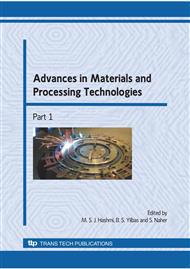[1]
T. Masuzawa, State of the art of micromachining. Ann. CIRP, Vol. 49 (2000) 473-88.
Google Scholar
[2]
H.S. Lim, Y.S. Wong, M. Rahman and M.K. Edwin Lee, A study on the machining of highaspect ratio micro-structures using micro-EDM. J. Mater. Process. Technol., Vol. 140 (2003) 318-25.
DOI: 10.1016/s0924-0136(03)00760-x
Google Scholar
[3]
H.S. Liu, B. H Yan, F.Y. Huang and K.H. Qiu, A study on the characterization of high nickel alloy micro-holes using micro-EDM and their applications. J. Mater. Process. Technol., Vol. 169 (2005) 418-26.
DOI: 10.1016/j.jmatprotec.2005.04.084
Google Scholar
[4]
T. Masuzawa, J. Tsukamota and M. Fujino, Drilling of Deep Microholes by EDM. Ann CIRP, Vol. 38 (1989) 195-98.
DOI: 10.1016/s0007-8506(07)62683-3
Google Scholar
[5]
B.H. Yan, F.Y. Huang, H.M. Chow and J.Y. Tsai, Micro-hole machining of carbide by electric discharge machining. J. Mater. Process. Technol., Vol. 87 (1999) 139-145.
DOI: 10.1016/s0924-0136(98)00345-8
Google Scholar
[6]
Y. Li, M. Guo, Z. Zhou and M. Hu, Micro electro discharge machine with an inchworm type of micro feed mechanism. Precis. Eng., Vol. 26 (2002) 7-14.
DOI: 10.1016/s0141-6359(01)00088-5
Google Scholar
[7]
Z. Wansheng, W. Zhenlong, D. Shichun, C. Guanxin and W. Hongyu, Ultrasonic and electric discharge machining to deep and small hole on titanium alloy. J. Mater. Process. Technol., Vol. 120 (2002) 101-6.
DOI: 10.1016/s0924-0136(01)01149-9
Google Scholar
[8]
S.H. Yeo, M. Murali and H.T. Cheah, Magnetic field assisted micro electro-discharge machining. J. Micromech. Microeng., Vol. 14 (2004) 1526-29.
DOI: 10.1088/0960-1317/14/11/013
Google Scholar
[9]
Z.Y. Yu, K.P. Rajurkar and H. Shen, High Aspect Ratio and Complex Shaped Blind Micro Holes by Micro EDM. Ann. CIRP, Vol. 51 (2002) 359-62.
DOI: 10.1016/s0007-8506(07)61536-4
Google Scholar
[10]
F.T. Weng, Electrodischarge machining of a coaxial array of microholes using a graphite copper electrode. Int. J. Adv. Manuf. Tech., Vol. 27 (2006) 1097-100.
DOI: 10.1007/s00170-004-2300-7
Google Scholar
[11]
P.C. Kaminski and M.N. Capuano, Micro hole machining by conventional penetration electrical discharge machine. Int. J. Mach. Tools Manuf., Vol. 43 (2003) 1143-49.
DOI: 10.1016/s0890-6955(03)00124-x
Google Scholar
[12]
D.J. Kim, S.M. Yi, Y.S. Lee and C.N. Chu, Straight hole micro EDM with a cylindrical tool using a variable capacitance method accompanied by ultrasonic vibration. J. Micromech. Microeng., Vol. 16 (2006) 1092-97.
DOI: 10.1088/0960-1317/16/5/031
Google Scholar
[13]
C. Diver, J. Atkinson, H.J. Helml and L. Li, Micro-EDM drilling of tapered holes for industrial applications. J. Mater. Process. Technol., Vol. 149 (2004) 296-303.
DOI: 10.1016/j.jmatprotec.2003.10.064
Google Scholar
[14]
B.H. Yan, A.C. Wang, C.Y. Huang and F.Y. Huang, Study of precision micro-holes in borosilicate glass using micro EDM combined with micro ultrasonic vibration machining. Int. J. Mach. Tools Manuf., Vol. 42 (2002) 1105-12.
DOI: 10.1016/s0890-6955(02)00061-5
Google Scholar
[15]
Y. Li, M. Guo, Z. Zhou and M. Hu, Micro electro discharge machine with an inchworm type of micro feed mechanism. Precis. Eng., Vol. 26 (2002) 7-14.
DOI: 10.1016/s0141-6359(01)00088-5
Google Scholar
[16]
J.C. Hung, J.K. Lin, B.H. Yan, H.S. Liu and P.H. Ho, Using a helical micro-tool in micro EDM combined with ultrasonic vibration for micro-hole machining. J. Micromech. Microeng, Vol. 16 (2006) 2705-13.
DOI: 10.1088/0960-1317/16/12/025
Google Scholar
[17]
M.G. Her and F.T. Weng, Micro-hole Machining of Copper Using the Electro-discharge Machining Process with a Tungsten Carbide Electrode Compared with a Copper Electrode. Int. J. Adv. Manuf. Tech., Vol. 17 (2001) 715-19.
DOI: 10.1007/s001700170116
Google Scholar
[18]
J.C. Hung, B.H. Yan, H.S. Liu and H.M. Chow, Micro-hole machining using micro-EDM combined with electropolishing. J. Micromech. Microeng., Vol. 16 (2006) 1480-86.
DOI: 10.1088/0960-1317/16/8/007
Google Scholar
[19]
Y.H. Jeong and B.K. Min, Geometry prediction of EDM-drilled holes and tool electrode shapes of micro-EDM process using simulation. Int. J. Mach. Tools Manuf., Vol. 47 (2007) 1817-26.
DOI: 10.1016/j.ijmachtools.2007.04.011
Google Scholar
[20]
F. Han, S. Wachi and M. Kunieda, Improvement of machining characteristics of micro-EDM using transistor type isopulse generator and servo feed control. Precis. Eng., Vol. 28 (2004) 378-85.
DOI: 10.1016/j.precisioneng.2003.11.005
Google Scholar
[21]
A. Gangadhar, M.S. Sunmugam and P.K. Philip, Pulse train studies in EDM with controlled pulse relaxation. Int. J. Mach. Tools Manuf., Vol. 32 (1992) 651-7.
DOI: 10.1016/0890-6955(92)90020-h
Google Scholar
[22]
F. Han, Y. Yamada, T. Kawakami and M. Kunieda, Experimental attempts of sub-micrometer order size machining using micro-EDM. Precis. Eng., Vol. 30 (2006) 123-31.
DOI: 10.1016/j.precisioneng.2005.06.005
Google Scholar
[23]
Y.S. Wong, M. Rahman, H.S. Lim, H. Han and N. Ravi, Investigation of micro-EDM material removal characteristics using single RC-pulse discharges. J. Mater. Process. Technol., Vol. 140 (2003) 303-7.
DOI: 10.1016/s0924-0136(03)00771-4
Google Scholar
[24]
P. Allen and X. Chen, Process simulation of micro electro-discharge machining on molybdenum. J. Mater. Process. Technol., Vol. 186 (2007) 346-55.
DOI: 10.1016/j.jmatprotec.2007.01.009
Google Scholar
[25]
S.M. Son, H.S. Lim, A.S. Kumar and M. Rahman, Influences of pulsed power condition on the machining properties in micro EDM. J. Mater. Process. Technol., Vol. 190 (2007) 73-6.
DOI: 10.1016/j.jmatprotec.2007.03.108
Google Scholar
[26]
C.T. Lin, H.M. Chow, L.D. Yang and Y.F. Chen, Feasibility study of micro-slit EDM machining using pure water. Int.J. Adv. Manuf. Technol., Vol. 34 (2007) 104-10.
DOI: 10.1007/s00170-006-0570-y
Google Scholar
[27]
D.K. Chung, B.H. Kim and C.N. Chu, Micro electrical discharge milling using deionized water as a dielectric fluid. J. Micromech. Microeng., Vol. 17 (2007) 867-74.
DOI: 10.1088/0960-1317/17/5/004
Google Scholar


